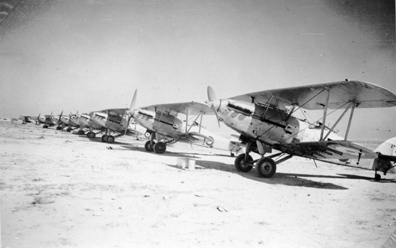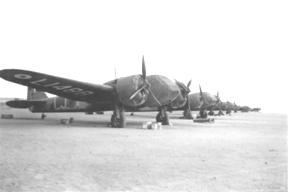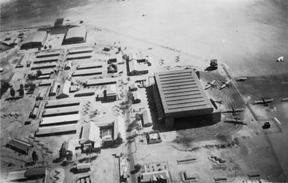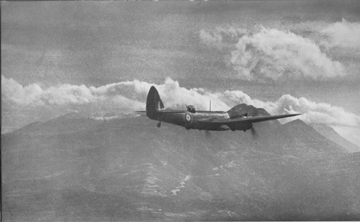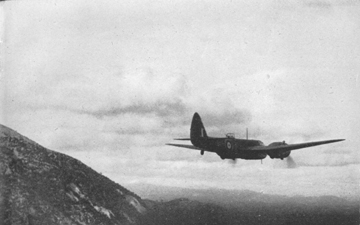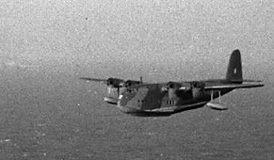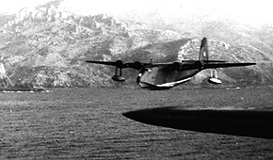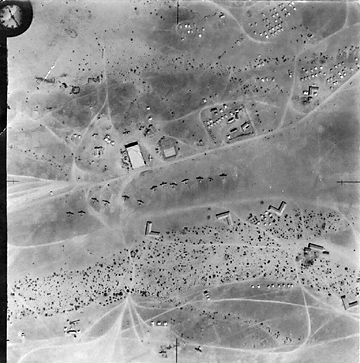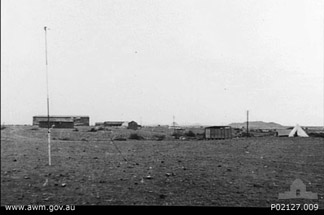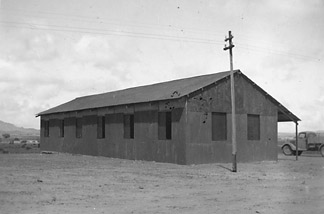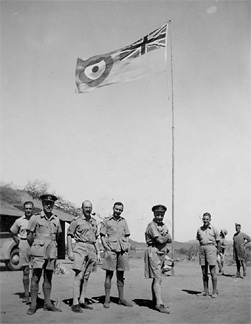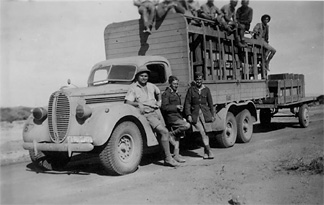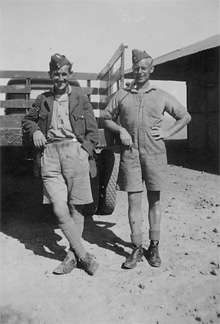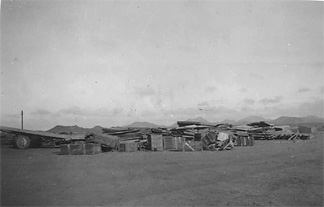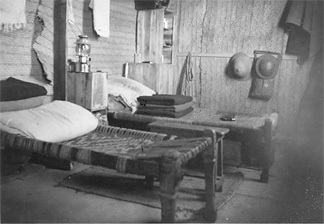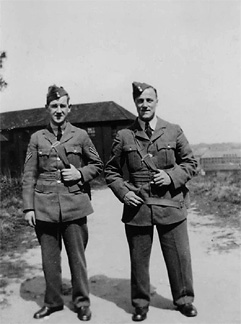 |
 |
|||||||||||||||||||||
|
The Middle East 1938-1942 211 starts afresh
Close inspection shows the leading three aircraft all bear the AO code. The second aircraft of the ten in this shot is AO-K. Dated Oct 38 on the rear. By the Spring of 1939 they had re-equipped with the Bristol Blenheim Mk I.
L1488 leading, LJ code in use. Middle East movements 211 Squadron’s establishment (their Initial Equipment or IE) was officially 12 aircraft. Of these, nine aircraft were expected to be fully serviceable at any one time. That is, nine aircraft (three flights of three) with their 27 aircrew was “maximum effort”—a full Squadron operation. In March 1940, the Squadron was made up to its war establishment, increasing the personnel strength of the Squadron to 361 officers and airmen. Aptly, the Squadron badge included the motto Toujours à propos (“always at the right moment”). With pride in their reputation for speedy deployment (and likewise aptly), they called themselves "The Greyhounds" and their various little bars “The Greyhound Inn” and the like.
Helwan was the site of a major RAF station in Egypt well before the war, on the edge of the eastern desert 15 miles (25 km) south of Cairo, both Nile and railway close at hand. The size of the encampment is readily seen. On the apron outside the vast main hangar are 6 Vickers Wellesleys, most probably of 45 Squadron. No dispersals but signs of a heightened state of readiness, with a number of slit trenches in evidence. Taken together, these suggest a date between the Munich crisis of October 1938 and June 1939, when 45 Squadron re-equipped with Blenheims. Italian adventures in Africa and Greece Italy’s belated declaration of war against France in June 1940 also brought the war to North Africa. The period June to September saw the Italians mount air attacks and a successful advance into Egypt from Libya. With confidence high after this African adventure, Mussolini made Greece an ultimatum on 28 October 1940. To the surprise of the Italians, the Greeks declined to surrender, strongly resisting the invasion that followed immediately through Albania. In North Africa, the Italian advance from Libya into Egypt had halted around Sidi Barrani in mid-September 1940. With considerable secrecy Wavell was in the process of building his forces for a response, the first of many see-saws across the Western Desert. Then the Italians struck at Greece. 1939 treaty obligations aside, the British government was quite determined to support the Greeks. Contemporary documents are guarded in their discussion of underlying strategic issues but it has become clear in recent years that, through Ultra intelligence, there was considerable awareness in London and in Cairo of the timing and weight of Italian preparations in Africa and Albania, and of German intentions in Eastern Europe. Mindful that the presence of British troops might provoke a German response, the Greeks called for air support only and declined other aid. At this stage of the war, the slender British Middle East forces were the only practical source for any such adventure, be it naval, ground or air. RAF Middle East and British Air Forces Greece Before the Italians struck, it had been Longmore who resisted all blandishments to divert aircraft to Greece. Now, aware of Wavell's pending December offensive in Egypt and against considerable barracking from the British ambassador to Greece, it was Anthony Eden in Cairo who counselled against further commitment. The Foreign Secretary pressed his case to Churchill by signal and by offering to return to London to amplify his position. As an increasingly testy Prime Minister signalled him “Do not return”, the CAS signalled Longmore to provide the greatest possible material support to Greece. Despite a possible fresh Italian advance into Egypt (and the pressing priority of air support for Wavell's planned counter-attack), Longmore took no half-measures. Recognising at the outset that the only possible contribution would be a token force at high risk of loss, Longmore sought the best chance of survival for his airmen by digging as deep as his short pockets would allow. Of the existing 16 Middle East squadrons, no less than one-quarter was detached forthwith to form British Air Forces Greece (BAFG). The force so formed represented near half the available fighter and bomber strength of the Command. Thus by the end of November, 30 Squadron had been joined by three more squadrons: 211 and 84 (with Blenheim Is) and 80 (Gloster Gladiators, re-equipped with Hawker Hurricanes in late February). With this small force, AVM JH D'Albiac DSO immediately set about providing strategic air support to the Greek counter-offensive. Through November and December, the Greeks rapidly drove the invading Italian forces from North-Western Greece and back into Albania. Despite poor winter weather and even poorer road and transport conditions, they stoutly resisted fresh Italian advances from early January. By late February, however, the military situation was such that the Greek government agreed to accept further air support and land forces as well. In an early December visit, 112 Squadron delivered Gladiators to the RAF and Royal Hellenic Air Force. By March, BAFG had been reinforced with the return of 112 Squadron (still with Gladiators) and the arrival of 113 and 11 Squadrons (Blenheim IVs) and 33 Squadron (Hurricanes). From Egypt, Vickers Wellingtons of 37 and 70 Squadrons operated mainly at night against Italian ports. BAFG had been formed on an undertaking of urgent re-supply of RAF Middle East from the UK. The further reinforcement of BAFG contemplated in Athens, Cairo and London could only then be achieved by the demanding convoy and air-ferry route through Takoradi on the West African Gold Coast and on to Egypt. The difficulties of this feat, first by convoy through hostile waters, followed by aircraft assembly at Takoradi, and then by air across 2,000 miles of desert, were not fully appreciated in London. Heated exchanges arose between Churchill and Longmore about the serviceable strength of ME Cmd as against (crated) aircraft sent from the UK. By 1942, the Takoradi route was indeed delivering splendid results but in 1941 the re-supply task was still truly formidable. While accounts of the order of battle differ within the various official records, as do accounts of losses, at its greatest strength BAFG comprised 10 operational RAF squadrons (2 of which were reconnaissance units), two FAA units and a number of other detachments, never reaching the mooted force of 14 Squadrons. 211 goes to Greece
A small fin flash, and no obvious aircraft codes (though such details were sometimes censored) Whatever the Greek Government's views on close support, it initially had the greatest reluctance to provide suitable forward all-weather landing grounds, again for fear of provoking a German response. Accordingly, 211 was posted initially to Tatoi (Menidi) near Athens. From there, it was a long and difficult flight in filthy winter weather to attack the Italian rear, deep in Albania. Typically, just one day after the air party's arrival at Menidi the Greyhounds mounted their first raid of the Greek campaign: a full squadron operation against Durazzo, on the coast of Albania some 350 miles from Athens. As BAFG reinforcements arrived, D'Albiac was able to offer closer support to the delight of the Greeks. The Squadron moved forward to Paramythia (literally, valley of legends) in NW Greece, with 80 Squadron at Yannina in support. When things hotted up in the early Spring 211 withdrew temporarily to Menidi, but were back at Paramythia by the last week of March 1941.
Again, the small flash and no visible codes. By early Spring (25 March), reverses inflicted on the Italians brought German forces into the campaign, first invading Yugoslavia and then, in overwhelming force from the North and North-East, Greece. British and Australian troops had barely arrived. The RAF as BAFG had at that date eight Squadrons of around 80 serviceable aircraft, facing about 160 Italian and perhaps 800 Luftwaffe (Luftflotte 4) aircraft. Easter Sunday 1941 Just two of the 18 aircrew survived, only to be shot down in another incident shortly after: thus only one of the 211 members who took part survived the raid. Two of the aircrew lost were not in fact 211 personnel, but were “having a look”—Wing Commander Coote and Squadron Leader Cryer, the OC Western Wing and his deputy. In 1993, the remains of one of the six lost Blenheims (Buchanan and co’s L1434) were recovered from Lake Mikro Prespa by a combined HAF/Army team. The story was briefly told in Aeroplane Monthly (October 1993) and at length in Blenheim Over the Balkans. The end in Greece
The RAF Narrative of the Greek campaign records that the four Blenheim bomber squadrons between them lost 91 aircraft, of which 61 were lost in battle. Total BAFG aircrew casualties were 148 killed and missing plus a further 15 prisoners of war. Of these 163 personnel, 150 were aircrew. Palestine In virtually continuous action for 12 months from June 1940, 211 Squadron aircrews had achieved enormous operations counts, The Bish chief among them with over 100 while many others recorded over 50. Wadi Gazouza The Squadron was withdrawn from Palestine to Wadi Gazouza in northern Sudan, where they were to operate as a reserve Squadron training mainly RAAF aircrew on Bristol Blenheim operations (and ultimately to provide a nucleus for the formation of No 72 Operational Training Unit to train much larger numbers of aircrew).
As also shown in Alan Conrad’s collection. North to the top. About eight miles East of Summit, the airfield lay astride the unsealed road to Erkowit.
W/Cdr DCR Macdonald was unimpressed with Wadi Gazouza as a site for a major training operation. So too was his successor as OC 72 OTU, Grp Cpt LR Stokes. If hampered initially by the small number of aircraft and their poor serviceability, training had begun by late June 1941. Although the Squadron record ceases in mid-July, by September training was a proceeding at better pace, as the Log Books and arrival dates of RAAF trainee aircrew indicate. On 12 November, 13 crews passed out of No 1 Blenheim Operations Course, the first and only to be completed at Wadi Gazouza under 211 Squadron arrangements. In mid-November, 72 OTU was formally established, absorbing the personnel of 211 Squadron personnel in the process. Then, on 19 December 1941, 72 OTU Movement Order No 2/1941 ordered the bulk of the ground personnel to depart Wadi Gazouza the following day, Saturday 20 December 1941, bound once more for Helwan. Many of them were old hands of the Squadron. In the Middle East, the RAF was preparing as rapidly as possible to reinforce the Far East theatre. The Japanese had entered the war just two weeks earlier: HMS Prince of Wales and HMS Repulse had already been sunk in the Gulf of Siam and the Imperial Japanese Army was advancing down the Malay peninsula upon Singapore. For 211 Squadron, their six months of recuperation in The Sudan was over. By 3 January 1942, No 2 Course had completed, the first under 72 OTU control, with seven crews passing out. The formation of 72 OTU and its close relationship and overlap with 211 Squadron is recorded in the narrative beginnings of the 72 OTU Operations Record Book. There, too, is to be found the Movement Order and its nominal roll of the Ground Party moving to re-form 211 Squadron, 293 officers and men, ordered to make their way by road, rail and Nile steamer to Helwan and work up to operational readiness and movement to the Far East. The corresponding order and roll for the Squadron's Air Party has not yet come to light. Although it took some time to replace all the instructing and ground staff so urgently posted away, by the end of January 1942, two further Blenheim Operations Courses had been competed: No 3 Course on 18 January (7 crews passing out) and No 4 Course on 31 January (with 10 crews). Their authorised strength (around 1,000 airmen) was eventually reached and in March 1942, the OTU moved to rather better conditions at Nanyuki in Kenya, continuing to train aircrew with Blenheims and Baltimores until May 1943.
A typical shot by Cpl Alick Goddard, of 52 Repair and Salvage Unit, when based there from late 1940. His photographs were consistently well-judged in subject, exposure and focus.
Presumably the officers of 52 R&SU and, from the sand, scrub and distant hills, at Wadi Gazouza in late 1940.
No notes on this shot, but Alick is there, third on the right, leaning against the truck, in blue tunic, forage cap and KD shorts. Plainly, these chaps are of the unit’s Mechanical Transport Section. The truck carries numerous men, plus a large crate and at least two more on the trailer. Possibly en route to Wadi Gazouza to set up.
Briefly captioned by him. In identical dress as the MT shot above, this scene with its sand and shed strongly suggests the MT Section at Wadi Gazouza around late 1940.
Print tersely captioned: “Dump”. Still, there’s no doubt as to place at all. The desolate scene is of Wadi Gazouza around late 1940—the identical range of hills appears, aptly enough, in my own father’s shot Towards the MT, Wadi Gazouza from late 1941.
Alick was pretty practised with his camera and low light didn’t faze him if the shot looked interesting. At Wadi Gazouza in 1940 or 1941, airmen up to Sergeant rank took their chance on whether they’d score a billet in one of the several airmen’s huts, or out among the tent-lines (as my father and Alan Conrad found). Here we see a corner inside of one of the airmen’s huts, with concrete floor and matting walls, occupied by two men and fitted out with packing case furnishings. Rope bedframes, blankets and “biscuits” (palliasses) all present and more or less correct, one of these two places is presumably Goddard’s own. Cpl AT Goddard 347476 and The Sudan
Alick in blues with his Corporal stripes up, with an airman mate at an RAF Home station, possibly Summer 1940. Airmen’s barracks behind to the left, while in the right background the distinctive double-row windows of an RAF hangar. Facilities just like this were certainly at Henlow, a major RAF station in Bedfordshire dating from 1917. Aptly, when the war spread to the Middle East in the Summer of 1940, it was at Henlow that No 52 Repair and Salvage Unit was formed, before proceeding to Khartoum in The Sudan that September. With them went Cpl Goddard. By December 1940, they were at Wadi Gazouza. Alick died in 1962, aged 60 years. In 2005, grandson Danny and his wife Wendy in Leicester got in touch and most kindly gave me his considerable collection of photographs to look after. Printed on 2.5” x 3.5” Velox paper, Alick had given brief notes on the back of quite a number, as here. Nearly all were stamped on the rear with initials in permanent ink: AG and presumably his own personal stamp. His images have added much to the picture of Service life in The Sudan, at Wadi Gazouza, at Gebeit, Summit and elsewhere in 1940 and 1941. 211 Losses 1940—1941
Over this period, 11 men of the Squadron were taken prisoner, of whom nine were aircrew: six in the Western Desert, and three in Greece. Another two men were taken prisoner in Greece on the ground, one of whom may have been aircrew. All 11 survived and four were able to succeed in escaping. In their first year of action, over 40 aircrew were lost in 15 aircraft from a Squadron establishment of 12 aircraft. Poor survival odds. The loss of 11 aircraft in Greece in two very short periods were blows that cannot adequately be described by anyone who was not there. “A very shaky do!”. Worse was to come. While stood down to work up the 72 OTU operation at Wadi Gazouza, the Squadron suffered the loss of Sgt JJ “Paddy” Kavanagh DFM (veteran of the Desert, Palestine and Greece) to natural causes. After their brief absorption into 72 OTU came the loss of two crews in training accidents: the all-Australian crew of Sgts Skinner, Dunstone and Thomson (killed in Blenheim IV Z9612), and of Pilot 748023 Sgt C Freeman, Observer P/O AC Smith RCAF, WOp/AG Sgt 755697 W Armour and trainees Observer Sgt 1251148 PP Hussey and WOp/AG Sgt 400575 PW Wheeler RAAF (missing presumed killed in Blenheim IV Z7628). Sources D'Albiac Report on Air Operations in Greece 1940—41 (London Gazette, Supplement, Jan 1947) Conrad corresp and photographs Cassidy Flying Empires (Queens Parade Press 2004)
www.211squadron.org © D Clark & others 1998—2025 |
|||||||||||||||||||||
